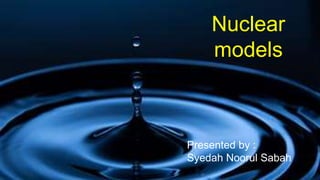
Nuclear models (1).pptx
- 1. Presented by: Syedah Noorul sabah Nuclear models Presented by : Syedah Noorul Sabah
- 2. Nuclear models can be classified into two main groups. a) Strong-interaction, or statistical models, b) Independent- particle models, Strong -interaction model or statistical model : This model is based on the assumption that the protons and neutrons are mutually coupled to each other and behave cooperatively in a way that reflects the short-ranged strong nuclear force between them. Examples : Liquid Drop model and Compound Nucleus Model. Independent -particle Model : This model is based upon main assumption that there is little or no interaction between the individual particles that constitute nuclei; each proton and neutron moves in its own orbit and behaves as if the other nuclear particles were passive participants.
- 3. Examples: Nuclear Shell Model and its variations. Other nuclear models: a) Collective Model b) Optical Model Collective Model put forwarded by Aage Bohr (son of Neils Bohr), incorporate aspects of both groups, that is ,it is a combination of the shell model and the liquid-drop model. Optical Model In this model nucleus is assumed as a medium having complex refractive index.
- 4. Liquid Drop Model This model was first proposed by George Gamow along with Weizsacher in 1935 who have recognized some experimental evidences and found resemblance of nucleus with a liquid drop and then developed by Niels Bohr and John Wheeler later on. The liquid drop model treats the nucleus as a drop of incompressible nuclear fluid of very high density.
- 5. ● Like the molecules in a drop of liquid, the nucleons are imagined to interact strongly with each other with almost same force. fn-n ~fn-p ~ fp-p ● Just like liquid molecules can collide with each other due to thermal agitation like wise nucleons collide frequently with each other in the nuclear interior, its mean free path as it moves about is substantially less than the nuclear radius. ● The liquid drop is assumed as incompressible meaning its density can’t be changed similar is the case for nucleus also where the density of the nucleus is constant for all the nuclei. ● The liquid drop is spherical because of surface tension similarly the nucleus is spherical because of the strong nuclear force. ● Heat of vaporization in liquid is comparable to binding energy of the nucleons in a nucleus.
- 6. ● Evaporation of a liquid drop corresponds to radioactive emission from a radioactive isotope. ● Surface tension in the liquid arises from the fact that surface molecules in a drop are not so tightly bound as are the molecules in the interior. There is evidence to show that is so in the case of nucleons present in a nucleus as well. ● In a liquid drop , molecules are influenced by only by those which lie in immediate neighbourhood. This means that intermolecular forces are short range forces only. The same is the case in a nucleus. The nucleon -nucleon forces operate within short ranges only. ● A nucleus may capture high energy particle to form compound nucleus in a similar manner as liquid drop may get excited , the excess of energy of captured particle being shared by all the particles of the nucleus or the drop.
- 7. Modes of de-excitation in compound nucleus and liquid drop Compound Nucleus Liquid Drop By emission of radiation By Cooling By emission of a nucleon By Evaporation By Nuclear fission By breaking into droplets Just as two liquid drops may undergo fusion to form a bigger drop , similarly two light nuclie may undergo fusion to form a bigger nucleus. As the model justifies the similarities between a liquid drop and a nucleus one can then construct a semiempirical model (half theory/half data) also known as Bethe- Weizacker Semi-empirical Mass Formula to account for the total nuclear binding energy, the most basic of nuclear properties. The values are in good agreement with experimental data.
- 8. Bethe-Weisacker’s SEMF: where, av = 14.1 MeV, as = 13.0 MeV, ac = 0.595 MeV, aa = 19.0 MeV, ap = 33.5 MeV.
- 9. Explanation of Nuclear fission on the basis of liquid Drop Model We know that the atomic nucleus behaves like the molecules in a drop of liquid. But in this nuclear scale, the fluid is made of nucleons (protons and neutrons), which are held together by the strong nuclear force. The interior nucleons are completely surrounded by other attracting nucleons just like molecules did in case of a liquid drop. In the ground state the nucleus is spherical. If the sufficient kinetic or binding energy is added, this spherical nucleus may be distorted into a dumbbell shape and due to positive charge repulsion on the two ends splits into two fragments hence, forming two daughter nuclei. This process is what we call nuclear fission.
- 10. Achievements of this model 1. It predicts the atomic masses and binding energies of various nuclei to a larger accuracy. 2. It predicts emission of alpha and beta particles in radioactivity. 3. The theory of compound nucleus, which is based on this model, explains the basic features of the nuclear fission process.
- 11. Failures of this model 1. It fails to explain the extra stability of certain nuclei, with the numbers of protons or neutrons are 2, 8, 20, 28, 50, 82 or 126 etc 2. It fails to explain the measured magnetic moments of many nuclei. 3. It also fails to explain the spin and parity of nuclei. 4. It is also not successful in explaining the excited states in most of the nuclei.